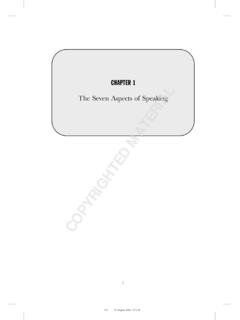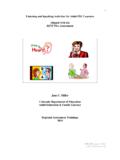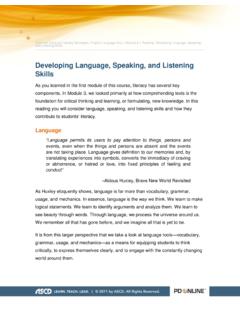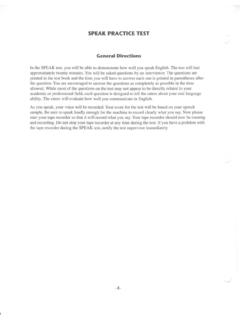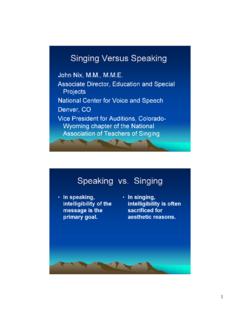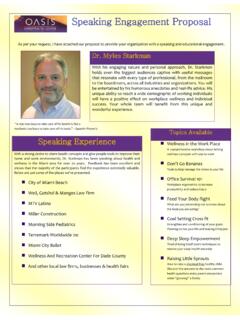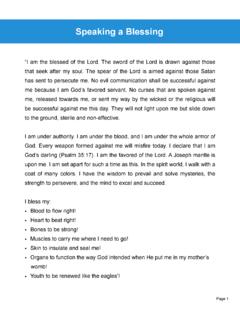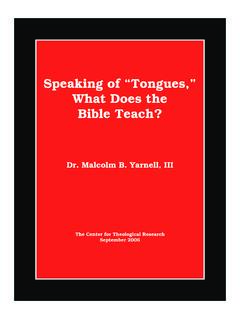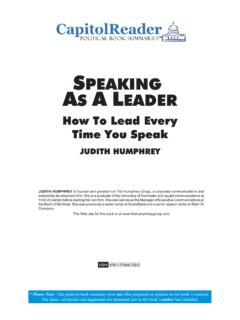Transcription of Speaking Sub -skills Teaching - Ken Lackman & Associates
1 Teaching Speaking Sub -skills Activities for Improving Speaking Ken Lackman kl+ Ken Lackman & Associates Educational Consultants Methods and activities for more effective Teaching with less preparation Teaching Speaking Sub -skills 1 2 3 4 4 7 7 9 10 13 14 16 18 19 22 Contents Introduction Speaking Sub -skills List Activities Fluency Accuracy with Words and Pronunciation Using Functions Appropriacy Turn-taking skills Relevant Length Responding and Initiating Repair and Repitition Range of Words and Grammar Using Discourse Markers Appendix Copyright Ken Lackman 2010. This work is the intellectual property of the author. Permission is granted for this material to be shared for non-commercial, educational purposes, provided that this copyright statement appears on the reproduced materials and notice is given that the copying is by permission of the author.
2 To disseminate otherwise or to republish requires written permission from the author. Teaching Speaking Sub -skills 2 Essentials for Language Learning Classroom vs. Real-world Speaking Two Warmers Introduction Rather than just have students speak in the classroom we should be Teaching students specific Speaking skills , known as sub -skills or micro skills . Since conversations outside the class are bound to be better learning experiences than those inside the class, rather than trying to duplicate real-world conversations in the classroom, we should be Teaching students skills they are not likely to learn outside the classroom. By raising awareness of Speaking sub -skills and providing classroom practice with them, we will be providing students with strategies to improve their communication outside the classroom, which is, or should be, the ultimate goal.
3 EXPOSURE to a rich but comprehensible input of real spoken and written language in use USE of the language to do things MOTIVATION to listen to and read the language and to speak and write it Jane Willis Classroom Use Real World Use Exposure T and non-proficient users (mostly other students) artificial Teacher chooses content limited native-like or a range authentic Student chooses content unlimited Use artificial determined by Teacher authentic determined by Student Motivation limited rewards rewarded by Teacher unlimited rewards rewarded by inter-personal or transactional success Barry s Activity A tell B about a holiday in excruciating detail. B show interest by using devices like: showing eye contact nodding your head saying, Is that so? saying, Really?
4 Saying, Uh-huh Last Weekend Answer these questions about last weekend: Did you have a good weekend? What was the best thing about your weekend? What was the worst thing about your weekend? Contrary to popular belief, Last Weekend, as it is, has little value as a classroom Speaking activity as it does not have students practice any sub -skills . It is not even set up to focus on fluency as the questions can be answered with one word. On the other hand, Barry s Activity encourages Fluency, Turn-taking skills and Responding and Initiating. Teaching Speaking Sub -skills 3 Speaking Sub -skills Sub -skills Application Fluency Students practice Speaking with a logical flow without planning or rehearsing. Activities which require students to focus on meaning in communication without immediate concern for accuracy (errors can be corrected afterwards).
5 Accuracy with Words & Pronunciation Students practice using words, structures and pronunciation accurately. Students need to be able to use and pronounce words and structures correctly in order to be understood. Controlled practice activities are the most common way of working on spoken accuracy. Using Functions Students use specific phrases for pur-poses like giving advice, apologizing, etc. Activities which stress that verbal communication is for a reason or function. Role plays and simulations are ideal. Appropriacy Students practice using language appropriate for a situation and making decisions about formality and choice of grammar or vocabulary. Activities which stress that the purpose of talking determines what language is appropriate. Students are required to make choices about grammar and vocabulary and also other aspects of communication like intonation and length of turn.
6 For example, What s the damage? is inappropriate in a four-star restaurant. Turn-taking skills Students practice ways of interjecting, eliciting an interjection or preventing one. Turn-taking skills involve knowing how and when to interject, eliciting an interjection or preventing one. Students can practice listening for appropriate gaps in order to take their turn without irritating the speaker. While Speaking they can practice techniques such as pausing which purposely allows others to take a turn or they can practice using hesitation devices such as 'ums' and 'errs' to hold on to a turn while they search for the next thing to say. Relevant Length Students practice Speaking at a length appropriate to a situation . Activities which demonstrate that the purpose of Speaking or the context determines the appropriate length of a turn.
7 For example, a one-word answer is acceptable for a market research survey but would not be sufficient in a job interview. Activities which require students to elaborate or be concise are useful. Responding and Initiating Students practice managing a conversation by making responses, asking for a response or introducing a new topic or idea. Activities which get students to practice managing a conversation in an appropriate way with specific words and phrases such as, What do you think , Speaking , Really? , etc. Gestures and other paralinguistic tools are also used in conversation management. Repair and Repetition Students practice repeating or rephrasing parts of a conversation when they suspect that what was said was not understood. The spontaneous nature of conversation requires that participants constantly have to make sure that what s being said is understood.
8 When misunderstanding is suspected, a participant will repair parts of the conversation. The most common form of repair is repetition and individual words or groups of words can be repeated by either the speaker or listener. Students can practice repairing when they suspect they haven t been understood or as listeners they can repeat to seek clarification or correction from the speaker. Range of Words and Grammar Students practice using particular grammar and/or vocabulary for Speaking on a specific topic or for doing a specific task. Students need to know a range of words and grammar and have the ability to choose from that bank the most appropriate words and structures for a specific task or topic. They are taught or made aware of words or structures appropriate for specific tasks or contexts and then are required to use them appropriately.
9 Discourse Markers Students practice using words/phrases which organize a talk ( firstly, secondly, on the other hand, to summarize) When speakers are required to take a particularly long turn, for example when giving a presentation, they use specific words and phrases to help the listener recognize how their talk has been organized. Activities can be used which teach discourse makers and then require students to use them appropriately. Teaching Speaking Sub -skills 4 Activities Fluency In Detail Speaking Listening Reading Writing Vocabulary Grammar Pronunciation Warmer/Icebreaker Students often have difficulty producing fluent speech simply because they lack the vocabulary or grammar to express what they want to express. This activity is designed to get them to speak at length about something they are very familiar with.
10 To start, choose a topic that you know students can speak about and then let them know what it is. For example, it could be what they did last night or last weekend/on their last holiday/etc. At lower levels, it could be what they do in a typical day. It could be to describe their home, to talk about their family, their hometown or country. Once you ve told them the topic, remind them that the purpose is to speak at length and put students in pairs. Tell them that one person in each pair is to speak at length on the topic for a certain period of time (usually two or three minutes) and give as much detail as possible. Ask listeners to respond using one or all of these: showing eye contact nodding your head saying, Is that so? saying, Really? saying, Uh-huh Also, let the listeners know that you will be asking them some questions about what their partner says (this ensures they listen).

